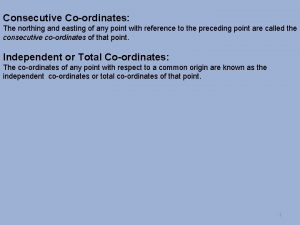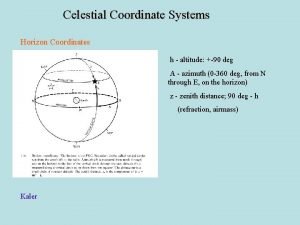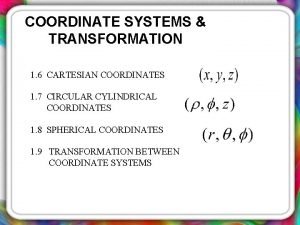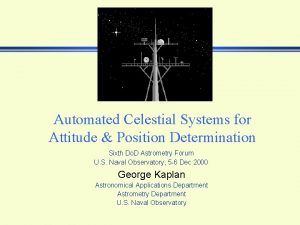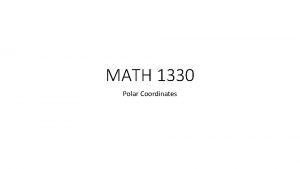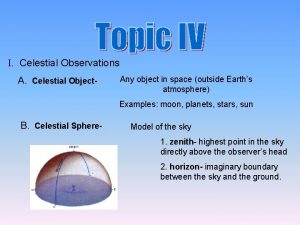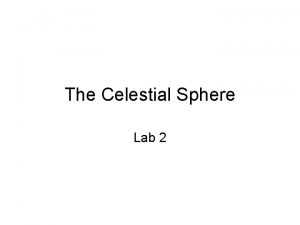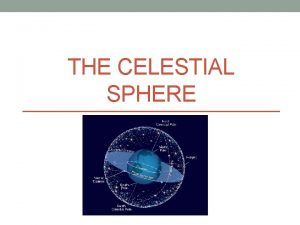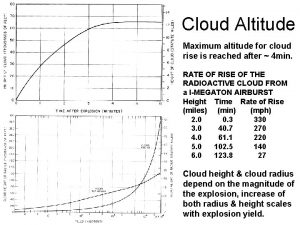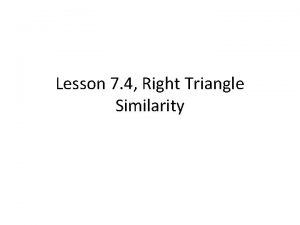Celestial Coordinate Systems Horizon Coordinates h altitude 90




























- Slides: 28

Celestial Coordinate Systems Horizon Coordinates h - altitude: +-90 deg A - azimuth (0 -360 deg, from N through E, on the horizon) z - zenith distance; 90 deg - h (refraction, airmass) Kaler

Equatorial Coordinates RA: 0 - 24 h (increases eastward from the Vernal Equinox) Dec: +- 90 deg H - hour angle: negative - east of the meridian, positive - west of the meridian. Tsid = RA + H Scott Birney

Ecliptic Coordinates Scott Birney - ecliptic longitude (0 -360 deg, increases eastwards from the Vernal equinox) - ecliptic latitude (+-90 deg) - Earth’s axial tilt = 23. 5 deg

Galactic Coordinates l - galactic longitude (0 -360 deg, increases toward galactic rotation from the galactic center b - galactic latitude, +- 90 deg The Galactic plane is inclined at an angle of 62. 6 deg to the celestial equator. RA (J 2000) Scott Birney Dec _________________ NGP: 192. 859 27. 128 GC: 266. 404 -28. 936

Galactic Coordinates (cont. ) l = 0 - Galactic center l = 90 - in the direction of Galactic rotation l = 180 - anticenter l = 270 - antirotation II III www. thinkastronomy. com IV I l = 0 - 90 first quadrant l = 90 - 180 second quadrant l = 180 - 270 third quadrant l = 270 - 230 fourth quadrant

Galactic Coordinates: Position and Velocity Components The cylindrical system R, z W (Z) R, - positive away from the GC - positive toward Galactic rotation z, W(Z) - positive toward the NGP Note: this is a left-handed coordinate system; right-handed W

The Cartesian system: defined with respect to the Local Standard of Rest (LSR) X, Y, Z U, V, W Z, W X, U - positive away from the GC Y, V - positive toward Gal. rotation X, U Z, W - positive toward NGP Left-handed system; right-handed: U= -U X = d cos l cos b Y = d sin l cos b Z = d sin b d - distance to the Sun Y, V

Coordinate Transformations 1) Spherical Trigonometry: Transformations Between Different Celestial Coordinate Systems Law of cosines: cos a = cos b cos c + sin b sin c cos A Law of sines: sin a sin b sin c ------ = ------- Kaler sin A sin B sin C And: cos A = - cos B cos C + sin B sin C cos a

Spherical Trigonometry: Transformations Between Different Celestial Coordinate Systems - Application: Equatorial <--> Galactic (BM - p. 31) Useful angles: G , G - eq. coordinates of the North Gal. Pole (G) longitude of the North Celestial Pole (P) (122. 932, defined as 123. 0 for RA, Dec. at B 1950)

Coordinate Transformations 2) Euler Angles: Transformations of Vectors (Position, Velocity) From One Coordinate System to Another The three basic rotations about x, y, z axes by a total amount of are equivalent to the multiplication of the matrices: (e. g. , Kovalewski & Seidelman ) Read Johnson and Soderblom (1987) for an application to positions and velocities determined from proper motions, RVs and parallax.

From Celestial Coordinates to Coordinates in the Focal Plane: The Gnomonic Projection Girard - MSW 2005

Standard Coordinates

Standard Coordinates Girard MSW 2005

Standard Coordinates

Trigonometric Parallax - The stellar parallax is the apparent motion of a star due to our changing perspective as the Earth orbits the Sun. -parsec: the distance at which 1 AU subtends an angle of 1 arcsec. Relative parallax - with respect to background stars which actually do move. Absolute parallax - with respect to a truly fixed frame in space; usually a statistical correction is applied to relative parallaxes.

Trigonometric Parallax Measured against a reference frame made of more distant stars, the target star describes an ellipse, the semi-major axis of which is the parallax angle (p or ), and the semiminor axis is cos , where is the ecliptic latitude. The ellipse is the projection of the Earth’s orbit onto the sky. Parallax determination: at least three sets of observations, because of the proper motion of the star. Van de Kamp

Parallax Measurements: The First Determinations All known stars have parallaxes less than 1 arcsec. This number is beyond the precision that can be achieved in the 18 th century. Tycho Brahe (1546 -1601) - observations at a precision of 15 -35”. Proxima Cen - 0. 772” - largest known parallax (Hipparcos value) 1838 - F. W. Bessel - 61 Cygni, 0. 31” +- 0. 02” ( modern = 0. 287”) 1840 - F. G. W. Struve for Vega ( Lyrae), 0. 26” (modern = 0. 129”) 1839 - T. Henderson for Centauri (thought to be Proxima!), 1. 16” +0. 11” (modern = 0. 742”) 1912 - Some 244 stars had measured parallaxes. Most measurements were done with micrometers, meridian transits, and few by photography.

Parallax Measurements: The Photographic Era Observatory Telescope* Percentage (%)** Yale (Johannesburg, South Africa) 26 -in f/16. 6 15. 5 Mc. Cormick (Charlottesville, VA) 26 -in, f/15 15. 4 Allegheny (Riverview Park, PA) 30 -in, f/18. 4 15. 1 Royal Obs. Cape of Good Hope (now SAAO) 24 -in, f/11 13. 9 Spoul (Swarthmore, PA) 24 -in. f/17. 9 10. 4 USNO (Flagstaff, AZ) 61 -in, f/10 reflector 6. 6 Royal Obs. Greenwich 26 -in, f/10. 2 6. 1 Van Vleck (Middletown, CT) 20 -in, f/16. 5 4. 7 Yerkes (Williams Bay, WI) 40 -in, f/18. 9 3. 6 Mt. Wilson (San Gabriel Mountains, CA) 60 -in, f/20 reflector 3. 5 * All are refractors unless specified otherwise ** by 1992; other programs, with lower percentages are not listed Source: nchalada. org/archive/NCHALADA_LVIII. html Accuracy: ~ 0. 010” = 10 mas

Parallax Measurements: The Modern Era Catalog Date #stars s(mas) Comments YPC 1995 8112 ± 15 mas Cat. of all π through 1995 USNO pg To 1992 ~1000 ± 2. 5 mas Photographic parallaxes USNO ccd From ‘ 92 ~150 ± 0. 5 mas CCD parallaxes Nstars & GB Current 100? ± 2 mas Southern π programs Hipparcos 1997 105 ± 1 mas First modern survey HST FGS 19952010? 100? ± 0. 5 mas A few important stars SIM 2016? 103 ± 4 µas Critical targets & exoplanets Gaia 2016? 109 ± 10µas “Ultimate” modern survey van Altena - MSW 2005

Parallax Precision and the Volume Sampled Photographic era: the accuracy is 10 mas -> 100 pc; Stars at 10 pc: have distances of 10 % of the distance accuracy Stars at 25 pc: have distances of 25 % of the distance accuracy By doubling the accuracy of the parallax, the distance reachable doubles, while the volume reachable increases by a factor of eight. Parallax Size to Various Objects • Nearest star (Proxima Cen) 0. 77 arcsec • Brightest Star (Sirius) 0. 38 arcsec • Galactic Center (8. 5 kpc) 0. 000118 arcsec 118 as • Far edge of Galactic disk (~20 kpc) 50 as • Nearest spiral galaxy (Andromeda Galaxy) 1. 3 as

Future Measurements of Parallaxes: SIM and GAIA 1% SIM 2. 5 kpc GAIA 0. 4 kpc Hipparcos 0. 01 kpc 10% 25 kpc 4 kpc 0. 1 kpc SIM 25 kpc (10%) SIM 2. 5 kpc (1%) You are here SIM(planetquest. jpl. nasa. gov)

Proper Motions: Barnard’s Star Van de Kamp

Proper Motions - reflect the intrinsic motions of stars as these orbit around the Galactic center. - include: star’s motion, Sun’s motion, and the distance between the star and the Sun. - they are an angular measurement on the sky, i. e. , perpendicular to the line of sight; that’s why they are also called tangential motions/tangential velocities. Units are arcsec/year, or mas/yr (arcsec/century). - largest proper motion known is that of Barnard’s star 10. 3”/yr; typical ~ 0. 1”/yr - relative proper motions; wrt a non-inertial reference frame (e. g. , other more distant stars) - absolute proper motions; wrt to an inertial reference frame (galaxies, QSOs) V 2 = V T 2 + V R 2

Proper Motions - is measured in seconds of time per year (or century); it is measured along a small circle; therefore, in order to convert it to a velocity, and have the same rate of change as , it has to be projected onto a great circle, and transformed to arcsec. - is measured in arcsec per year (or century); or mas/yr; it is measured along a great circle.

Proper Motions

Proper Motions - Some Well-known Catalogs High proper-motion star catalogs > Luyten Half-Second (LHS) - all stars > 0. 5”/yr > Luyten Two-Tenth (LTT) - all stars > 0. 2”/year > Lowell Proper Motion Survey/Giclas Catalog - > 0. 2”/yr High Precision and/or Faint Catalogs Ø HIPPARCOS - 1989 -1993; 120, 000 stars to V ~ 9, precision ~1 mas/yr Ø Tycho (on board HIPPARCOS mission) - 1 million stars to V ~ 11, precision 20 mas/yr (superseded by Tycho 2). Ø Tycho 2 (Tycho + other older catalogs time baseline ~90 years) - 2. 5 million stars to V ~ 11. 5, precision 2. 4 -3 mas/yr Ø Lick Northern Proper Motion Survey (NPM) - ~ 450, 000 objects to V ~ 18, precision ~5 mas/yr Ø Yale/San Juan Southern Proper Motion Survey (SPM); 10 million objects to V ~ 18, precision 3 -4 mas/yr.

Precession The system of equatorial coordinates is not inertial, because the NCP and the vernal equinox (VE) move (mainly due to the precession of the Earth). - It amounts to 50. 25”/year (or a period of 25, 800 years); the VE moves westward. - Tropical year: 365. 2422 days (Sun moves from one VE to the next; shorter by 20 minutes than the sidereal year. - Sidereal year: 365. 2564 day (Sun returns to the same position in the sky as given by stars). - Therefore the equatorial coordinates are given for a certain equinox (e. g. 1950, or 2000); for high proper-motion stars, coordinates are also given for a certain epoch. Van de Kamp

Astrometric Systems (Reference Frames) A catalog of objects with absolute positions and proper motions: i. e. , with respect to an inertial reference frame define an astrometric system. This system should have no rotation in time. 1) The dynamical definition: definition - with respect to an ideal dynamical celestial reference frame, stars move so that they have no acceleration. The choice of this system is the Solar System as a whole. Stars in this system have positions determined with respect to observed positions of planets. Observations made with meridian circles contribute to the establishment of this type of reference frame (FK 3, FK 4, FK 5 systems). 2) The kinematic definition: - an ideal kinematic celestial frame assumes that there exists in the Universe a class of objects which have no global systemic motion and therefore are not rotating in the mean. These are chosen to be quasars and other extragalactic radio sources (with precise positions from VLBI). This system is the International Celestial Reference System (ICRS, Arial et al. 1995).
 Consecutive coordinates and independent coordinates
Consecutive coordinates and independent coordinates Homogeneous coordinates vs cartesian coordinates
Homogeneous coordinates vs cartesian coordinates Polar derivative
Polar derivative Horizon coordinate system
Horizon coordinate system Pre coordinate indexing system
Pre coordinate indexing system Meaning of coordinate bond
Meaning of coordinate bond Differential surface area in cylindrical coordinates
Differential surface area in cylindrical coordinates Rotating coordinate systems
Rotating coordinate systems Querido padre celestial te agradezco por
Querido padre celestial te agradezco por Automated celestial navigation system
Automated celestial navigation system Diagonal lines in haircutting
Diagonal lines in haircutting Pathfinder shooting star
Pathfinder shooting star Sede perfeitos como vosso pai celestial é perfeito
Sede perfeitos como vosso pai celestial é perfeito Apocalipsis 4:1
Apocalipsis 4:1 Quoar
Quoar Querido padre celestial te agradezco por
Querido padre celestial te agradezco por Te rogamos señor que derrames tu gracia en nuestras almas
Te rogamos señor que derrames tu gracia en nuestras almas Querido padre celestial
Querido padre celestial Hoy nace una clara estrella
Hoy nace una clara estrella Celestial bodies context clues
Celestial bodies context clues Sees the celestial
Sees the celestial Local hour angle
Local hour angle Padre celestial al entrar en mi lugar de trabajo
Padre celestial al entrar en mi lugar de trabajo Querido padre celestial te agradezco por
Querido padre celestial te agradezco por Padre celestial al entrar en mi lugar de trabajo
Padre celestial al entrar en mi lugar de trabajo Cantos de apocalipsis
Cantos de apocalipsis Celestial event
Celestial event Deus nosso pai celestial
Deus nosso pai celestial Biografia de tristan tzara
Biografia de tristan tzara
